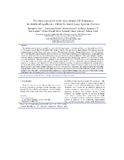Please use this identifier to cite or link to this item:
http://hdl.handle.net/10311/400Full metadata record
| DC Field | Value | Language |
|---|---|---|
| dc.contributor.author | Le Gall, B. | - |
| dc.contributor.author | Tshoso, G. | - |
| dc.contributor.author | Dyment, J. | - |
| dc.contributor.author | Kampunzu, A.B. | - |
| dc.contributor.author | Jourdan, F. | - |
| dc.contributor.author | Fe´raud, G. | - |
| dc.contributor.author | Bertrand, H. | - |
| dc.contributor.author | Aubourg, C. | - |
| dc.contributor.author | Ve´tel, W. | - |
| dc.date.accessioned | 2009-10-28T07:17:37Z | - |
| dc.date.available | 2009-10-28T07:17:37Z | - |
| dc.date.issued | 2005 | - |
| dc.identifier.citation | Le Gall, B. et al (2005) The Okavango giant mafic dyke swarm (NE Botswana): its structural significance within the Karoo Large Igneous Province, Journal of Structural Geology, vol. 27, pp. 2234 - 2255 | en_US |
| dc.identifier.issn | 0191-8141 | - |
| dc.identifier.uri | http://hdl.handle.net/10311/400 | - |
| dc.description.abstract | The structural organization of a giant mafic dyke swarm, the Okavango complex, in the northern Karoo Large Igneous Province (LIP) of NE Botswana is detailed. This N1108E-oriented dyke swarm extends for 1500 km with a maximum width of 100 km through Archaean basement terranes and Permo-Jurassic sedimentary sequences. The cornerstone of the study is the quantitative analysis of NO170 (exposed) and NO420 (detected by ground magnetics) dykes evidenced on a ca. 80-km-long section lying in crystalline host-rocks, at high-angle to the densest zone of the swarm (Shashe area). Individual dykes are generally sub-vertical and parallel to the entire swarm. Statistical analysis of width data indicates anomalous dyke frequency (few data !5.0 m) and mean dyke thickness (high value of 17 m) with respect to values classically obtained from other giant swarms. Variations of mean dyke thicknesses from 17 (N1108E swarm) to 27 m (adjoining and coeval N708E giant swarm) are assigned to the conditions hosting fracture networks dilated as either shear or pure extensional structures, respectively, in response to an inferred NNW–SSE extension. Both fracture patterns are regarded as inherited brittle basement fabrics associated with a previous (Proterozoic) dyking event. The Okavango N1108E dyke swarm is thus a polyphase intrusive system in which total dilation caused by Karoo dykes (estimated frequency of 87%) is 12.2% (6315 m of cumulative dyke width) throughout the 52-km-long projected Shashe section. Assuming that Karoo mafic dyke swarms in NE Botswana follow inherited Proterozoic fractures, as similarly applied for most of the nearly synchronous giant dyke complexes converging towards the Nuanetsi area, leads us to consider that the resulting triple junction-like dyke/fracture pattern is not a definitive proof for a deep mantle plume in the Karoo LIP. | en_US |
| dc.language.iso | en | en_US |
| dc.publisher | Elsevier www.elsevier.com/locate/jsg | en_US |
| dc.subject | Structure | en_US |
| dc.subject | Giant mafic dyke swarm | en_US |
| dc.subject | Okavango | en_US |
| dc.subject | Karoo Large Igneous Province | en_US |
| dc.subject | Botswana | en_US |
| dc.title | The Okavango giant mafic dyke swarm (NE Botswana): its structural significance within the Karoo Large Igneous Province | en_US |
| dc.type | Published Article | en_US |
| Appears in Collections: | Research articles (Dept of Geology) | |
Files in This Item:
| File | Description | Size | Format | |
|---|---|---|---|---|
| Kampunzu2005Okavangogiant.pdf | 3.38 MB | Adobe PDF |  View/Open |
Items in DSpace are protected by copyright, with all rights reserved, unless otherwise indicated.
